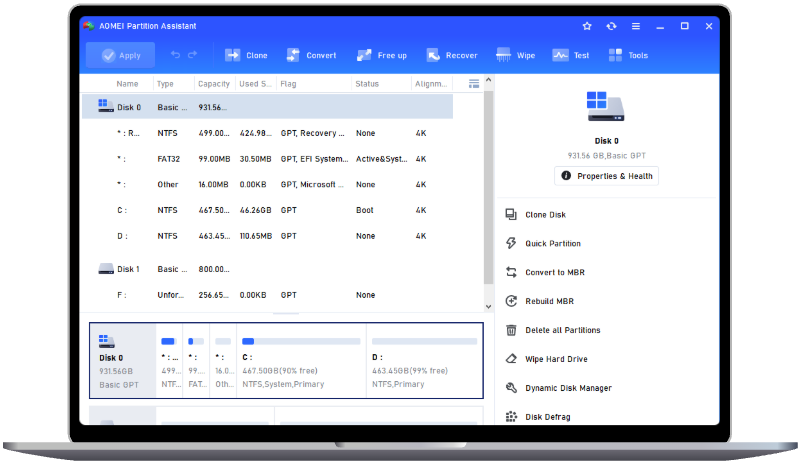How to Fix No Operating System Found Problem [4 Ways]
The "No Operating System Found" error indicates that your computer cannot locate the operating system necessary to start up, often due to boot issues. This guide explores the potential causes behind this error and provides practical solutions for resolving the "No Operating System Found" problem in Windows 11, 10, 8, or 7.
Why is there no operating system found?
When your computer displays the message "No operating system found", it means your device cannot locate a valid operating system to boot. This error prevents your system from starting and often leaves users confused about the root cause. Let's dive into the potential reasons behind this issue and how you can resolve it.
Boot order is misconfigured: The boot sequence in your computer’s BIOS/UEFI determines where the system looks for the operating system. If the boot order is set incorrectly, the system might attempt to boot from a device without an operating system.
➢ Hard drive connection issues: The hard drive storing your operating system might be disconnected or experiencing physical issues.
➢ Corrupted boot configuration: The Boot Configuration Data (BCD) is essential for starting your operating system. If the BCD is missing or corrupted, the system will fail to locate the OS.
➢ Operating system is missing or corrupted: If critical system files are damaged or the OS has been accidentally deleted, the system won't boot.
➢ Failing hard drive: A failing or damaged hard drive might be unreadable, causing the system to fail to find the OS.
➢ Partition issues: The boot partition containing the OS may not be marked as active, or the partition table could be damaged.
➢ BIOS/UEFI configuration errors: Certain BIOS/UEFI settings, such as secure boot or legacy mode, might prevent the system from finding the OS.
5 ways to fix “no operating system found” error in Windows
Encountering the "No Operating System Found" error can be frustrating, but the good news is that there are several effective methods to resolve it. Below are five proven ways to address this issue and get your system back up and running.
Way 1. Test hard drive problems
A malfunctioning or improperly connected hard drive is a common reason for this error. Testing the hard drive can help you diagnose and resolve the problem.
Step 1. Restart your computer and access the BIOS/UEFI by pressing a key like F2, Del, or Esc during startup.
Step 2. Check if the hard drive is recognized under the Storage Devices or Hard Drive Information section.
Step 3. Run a built-in diagnostic test if available in the BIOS.
Step 4. Alternatively, boot from a USB containing diagnostic software like CHKDSK or the hard drive manufacturer’s diagnostic tools.
Step 5. Repair or replace the hard drive if issues are detected.
Way 2. Reset the BIOS
Incorrect BIOS settings can prevent your system from detecting the operating system. Resetting the BIOS to its default configuration can resolve this.
Step 1. Restart your computer and enter the BIOS/UEFI by pressing the appropriate key during startup.
Step 2. Locate the option to Reset to Default Settings or Load Setup Defaults (specific wording may vary).
Step 3. Confirm the reset and select Save and Exit to save changes.
Step 4. Reboot your system to check if the issue is resolved.
Way 3. Enable or disable UEFI Secure Boot
The Secure Boot feature in UEFI is designed to enhance security, but it can sometimes interfere with the boot process, especially on older systems or with certain configurations.
Step 1. Enter the BIOS/UEFI by restarting your computer and pressing the designated key during startup.
Step 2. Navigate to the Boot or Security tab.
Step 3. Locate the Secure Boot option and toggle it On or Off based on your system’s requirements.
Step 4. Save changes and exit the BIOS.
Step 5. Restart your system to see if the problem is resolved.
Way 4. Activate the Windows partition
The "Operating System Not Found" error may occur if the Windows partition is not set as active. This issue can be resolved using the Diskpart tool, but you’ll need a Windows installation media USB to proceed. Follow these steps to fix the issue:
Step 1. Connect the Windows installation media to your computer and boot from it. If necessary, adjust the boot order in the BIOS menu to prioritize the USB drive.
Step 2. Once on the Windows Setup screen, select your preferred language and time format, then click "Next". Choose the "Repair your Computer" option to continue.
Step 3. Navigate to Troubleshoot > Advanced Options > Command Prompt.
Step 4. In the Command Prompt window, type the following commands and press “Enter” after each one:
• diskpart
• list disk: A list of all the disks attached to your machine will be displayed. Find out the system disk.
• select disk [number]: replace [number] with the system disk number.
• list volume: it will show you all partitions on your selected disk.
• select volume [number]: replace [number] with the system partition number.
• active
Step 5. After completing these steps, exit the Command Prompt, restart your computer, and check if the issue persists.
Way 5. Repair MBR
If the previous methods fail to resolve the issue, the "Operating System Not Found" error in Windows 11/10 might be caused by a corrupted Master Boot Record (MBR). To fix this, you can repair the MBR using the following commands in the Command Prompt (accessed as described in Method 4):
bootrec.exe /fixmbr
bootrec.exe /fixboot
bootrec.exe /scanos
bootrec.exe /rebuildbcd
For those without Windows installation media to access the Command Prompt, AOMEI Partition Assistant offers an excellent alternative. This tool enables you to create a Windows PE bootable media and rebuild the damaged MBR effortlessly. Follow these steps for a streamlined repair process:
Step 1. Connect a blank USB drive to another Windows computer that can boot up normally. Download, install and launch the AOMEI Partition Assistant Professional on that PC as well.
Step 2. Click "Tools" > "Make Bootable Media" on the upper interface, a window pops up, click "Next".
Step 3. In the next window, choose "USB boot device", then press "Proceed".
Step 4. Click "Finish" when the operation is done.
Step 5. Boot your Windows from the WinPE bootable USB you created. It contains the preinstalled AOMEI Partition Assistant Professional Demo software. Once log in, the software will run automatically.
Step 6. Right-click the system disk and choose “Rebuild MBR”.
Step 7. Choose the proper MBR type for your current OS.
Step 8. Click on “Apply” and “Proceed” to commit the pending operation.
Conclusion
The solutions outlined above address the "Operating System not found" error in Windows 11/10. AOMEI Partition Assistant stands out by offering simpler and more efficient methods for resolution. In addition, it provides a comprehensive suite of disk management tools, including advanced features such as disk and partition cloning, secure hard drive wiping, MBR2GPT conversion, and OS migration to SSD.


